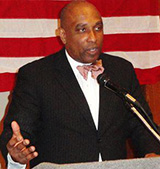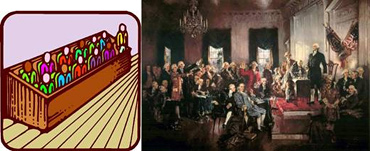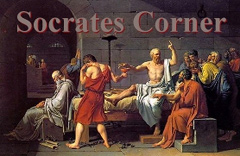
Ellis Washington
The Second and Seventh Amendments: History triumphs over balancing tests
By Ellis Washington

I consider [trial by jury] as the only anchor ever yet imagined by man, by which a government can be held to the principles of its constitution. ~ Thomas Jefferson letter to Thomas Paine
For example, while the number of jurors (12) has been reduced from which was the common-law standard (6), and although parties may waive their right to trial by jury in favor of a direct verdict, other notable aspects of the common-law tradition like the unanimous verdict requirement and the financial threshold amendment remain intact. Congress has also revised the $20 threshold for the right to a trial by jury. The amount is now $75,000. Finally, the Seventh Amendment is an unincorporated right meaning that it has never been incorporated to the states through the Fourteenth Amendment's due process clause.
In an important law review article by Darrell A. H. Miller, "The Yale Law Journal Text, History, and Tradition: What the Seventh Amendment Can Teach Us about the Second,", the writer surprisingly employs a non-balancing test, anti-progressive approach to interpreting the Seventh Amendment based on history and the original intent of the constitutional framers. Miller writes:
Therefore, the Second Amendment and the Seventh Amendment do not operate with conventional levels of scrutiny or open-ended balancing tests spawned by in my opinion the unconstitutional progeny of that infamous footnote four of Carolene Products v. U.S. (1938) and first presented in Korematsu, v. U.S. (1944) (Court ruled on the constitutionality of FDR's Executive Order 9066, which ordered Japanese Americans into internment camps during World War II regardless of citizenship), yet the "preserved" right to a trial by jury does not require that every detail of 1791 common law be transposed to the twenty-first century.
"Instead of levels of scrutiny or balancing, the Court has devised a 'historical test' for the Seventh Amendment. The Court's historical test places great, but not exclusive, reliance on analogical reasoning from text, common law history, or tradition to determine the constitutionality of any given practice or regulation," Miller writes. That procedure of reasoning by historical comparison defines the Seventh Amendment inquiry in a manner that supersedes the Court's approach to other provisions in the Bill of Rights.
The Court's controversial efforts to implement the Seventh Amendment through a historical test began in the two controversial cases: 1) D.C. v. Heller (2008) (Court held that the Second Amendment to the United States Constitution protects an individual's right to possess a firearm for traditionally lawful purposes, such as self-defense within the home and within federal territories) and 2) McDonald v. Chicago (2010) (Court determined whether the Second Amendment applies to the individual states). As a result, the Roberts Court interpretation was based on a historical test that attempts to remain true to the Seventh Amendment text, history, and the original traditions of the framers, but concurrently flexible enough to speak to the judicial burdens of the twenty-first-century. These landmark cases seem to compel the Court to a history-centered approach in Second Amendment cases as opposed to the extra-constitutional balancing test approach favored by progressive jurists and the political left beginning with the Carolene Products case 75 years ago.
Although both conservative and progressive members on the Court appear distrustful of a literal application of the text, yet the Heller majority and dissenters disagree on the process of establishing limits. The Heller majority insists that the extent of the right must originate in history, thus they categorically reject the liberal/progressive minority view of balancing tests. Although the Court has yet to delineate how such a history-centered test may operate in litigation, yet it appears that the Court is serious about rejecting balancing and embracing history because "borrowing" from the Court's Seventh Amendment jurisprudence can provide clues about how courts may craft a history-centered test for the Second Amendment.
Paraphrasing Alexander Hamilton I truly believe that "The civil jury [and a well armed militia] are valuable safeguards to liberty." This can only be achieved with a moral interpretation of the Bill of Rights based not in unconstitutional balancing tests, Social Darwinism, socialism and progressive politics, but on history, morals, the original intent of the constitutional framers and truth.
Book Notice
Please purchase my latest opus dedicated to that Conservative Colossus, Supreme Court Justice Clarence Thomas. Here are the latest two new volumes from my ongoing historical series – THE PROGRESSIVE REVOLUTION: History of Liberal Fascism through the Ages (University Press of America, 2015):
However, before the book is officially released to the public, I have to place 100 pre-publication orders (50 orders per each volume). I need your help to make this happen ASAP. Please place your order today for Volume 3 & Volume 4. Of course, if you can order all 100 copies today, the book will become official tomorrow.
Please circulate this flyer to all your email contacts & Facebook/Twitter followers who may be interested in purchasing this opus which will serve as a ready apologetic against the rampant Marxist-Progressive propaganda taught in America's public schools, colleges, universities, graduate schools, and law schools. Thanks in advance to all my friends, associates and colleagues for your invaluable support! Law and History Blog: www.EllisWashingtonReport.com
 Invitation for manuscripts
Invitation for manuscripts
I am starting a new a program on my blog dedicated to giving young conservatives (ages 14-35) a regular place to display and publish their ideas called Socrates Corner. If you know of any young person who wants to publish their ideas on any subject, have them send their essay manuscripts to my email at ewashington@wnd.com.
© Ellis Washington
March 17, 2013

I consider [trial by jury] as the only anchor ever yet imagined by man, by which a government can be held to the principles of its constitution. ~ Thomas Jefferson letter to Thomas Paine
-
Second Amendment – A well regulated Militia, being necessary to the security of a free State, the right of the people to keep and bear Arms, shall not be infringed.
Seventh Amendment – In Suits at common law, where the value in controversy shall exceed twenty dollars, the right of trial by jury shall be preserved, and no fact tried by a jury, shall be otherwise reexamined in any Court of the United States, than according to the rules of the common law.
For example, while the number of jurors (12) has been reduced from which was the common-law standard (6), and although parties may waive their right to trial by jury in favor of a direct verdict, other notable aspects of the common-law tradition like the unanimous verdict requirement and the financial threshold amendment remain intact. Congress has also revised the $20 threshold for the right to a trial by jury. The amount is now $75,000. Finally, the Seventh Amendment is an unincorporated right meaning that it has never been incorporated to the states through the Fourteenth Amendment's due process clause.
In an important law review article by Darrell A. H. Miller, "The Yale Law Journal Text, History, and Tradition: What the Seventh Amendment Can Teach Us about the Second,", the writer surprisingly employs a non-balancing test, anti-progressive approach to interpreting the Seventh Amendment based on history and the original intent of the constitutional framers. Miller writes:
-
The Court's nascent Second Amendment jurisprudence is a riddle because while the Court demands the most scrupulous investigation of history and a near-blanket prohibition on balancing, it also states that a number of modern regulations are "presumptively lawful" despite their dubious historical provenance or their interest-balancing origins.
The Court's challenge has left many judges frustrated because, as discussed in more detail below, the Court's demands appear to be facially irreconcilable. Some judges have answered by mechanically citing broad dicta in Heller and McDonald concerning these "presumptively lawful" regulations, rather than conducting the historical inquiry the Court ostensibly demands. Other judges have simply ignored the Court's rejection of balancing tests. Instead, they have allowed the right to keep and bear arms to be gobbled up by intermediate scrutiny or similar tests that weigh serious, important, or compelling government interests against Second Amendment commands.
... [T]hese lower court efforts to fashion a test simply cannot be squared with the Court's insistence on historical fidelity, its rejection of balancing, and the preservation of most reasonable firearm regulations. It assumes that the Court is serious when it instructs lower courts to avoid tests that call for any balancing at all, even if that means, as some lower court judges have said, eliminating the traditional levels-of-scrutiny analysis in Second Amendment cases.
Therefore, the Second Amendment and the Seventh Amendment do not operate with conventional levels of scrutiny or open-ended balancing tests spawned by in my opinion the unconstitutional progeny of that infamous footnote four of Carolene Products v. U.S. (1938) and first presented in Korematsu, v. U.S. (1944) (Court ruled on the constitutionality of FDR's Executive Order 9066, which ordered Japanese Americans into internment camps during World War II regardless of citizenship), yet the "preserved" right to a trial by jury does not require that every detail of 1791 common law be transposed to the twenty-first century.
"Instead of levels of scrutiny or balancing, the Court has devised a 'historical test' for the Seventh Amendment. The Court's historical test places great, but not exclusive, reliance on analogical reasoning from text, common law history, or tradition to determine the constitutionality of any given practice or regulation," Miller writes. That procedure of reasoning by historical comparison defines the Seventh Amendment inquiry in a manner that supersedes the Court's approach to other provisions in the Bill of Rights.
The Court's controversial efforts to implement the Seventh Amendment through a historical test began in the two controversial cases: 1) D.C. v. Heller (2008) (Court held that the Second Amendment to the United States Constitution protects an individual's right to possess a firearm for traditionally lawful purposes, such as self-defense within the home and within federal territories) and 2) McDonald v. Chicago (2010) (Court determined whether the Second Amendment applies to the individual states). As a result, the Roberts Court interpretation was based on a historical test that attempts to remain true to the Seventh Amendment text, history, and the original traditions of the framers, but concurrently flexible enough to speak to the judicial burdens of the twenty-first-century. These landmark cases seem to compel the Court to a history-centered approach in Second Amendment cases as opposed to the extra-constitutional balancing test approach favored by progressive jurists and the political left beginning with the Carolene Products case 75 years ago.
Although both conservative and progressive members on the Court appear distrustful of a literal application of the text, yet the Heller majority and dissenters disagree on the process of establishing limits. The Heller majority insists that the extent of the right must originate in history, thus they categorically reject the liberal/progressive minority view of balancing tests. Although the Court has yet to delineate how such a history-centered test may operate in litigation, yet it appears that the Court is serious about rejecting balancing and embracing history because "borrowing" from the Court's Seventh Amendment jurisprudence can provide clues about how courts may craft a history-centered test for the Second Amendment.
Paraphrasing Alexander Hamilton I truly believe that "The civil jury [and a well armed militia] are valuable safeguards to liberty." This can only be achieved with a moral interpretation of the Bill of Rights based not in unconstitutional balancing tests, Social Darwinism, socialism and progressive politics, but on history, morals, the original intent of the constitutional framers and truth.
Book Notice
Please purchase my latest opus dedicated to that Conservative Colossus, Supreme Court Justice Clarence Thomas. Here are the latest two new volumes from my ongoing historical series – THE PROGRESSIVE REVOLUTION: History of Liberal Fascism through the Ages (University Press of America, 2015):
However, before the book is officially released to the public, I have to place 100 pre-publication orders (50 orders per each volume). I need your help to make this happen ASAP. Please place your order today for Volume 3 & Volume 4. Of course, if you can order all 100 copies today, the book will become official tomorrow.
Please circulate this flyer to all your email contacts & Facebook/Twitter followers who may be interested in purchasing this opus which will serve as a ready apologetic against the rampant Marxist-Progressive propaganda taught in America's public schools, colleges, universities, graduate schools, and law schools. Thanks in advance to all my friends, associates and colleagues for your invaluable support! Law and History Blog: www.EllisWashingtonReport.com
 Invitation for manuscripts
Invitation for manuscriptsI am starting a new a program on my blog dedicated to giving young conservatives (ages 14-35) a regular place to display and publish their ideas called Socrates Corner. If you know of any young person who wants to publish their ideas on any subject, have them send their essay manuscripts to my email at ewashington@wnd.com.
© Ellis Washington
The views expressed by RenewAmerica columnists are their own and do not necessarily reflect the position of RenewAmerica or its affiliates.
(See RenewAmerica's publishing standards.)





















